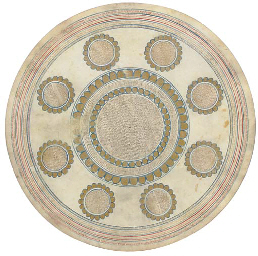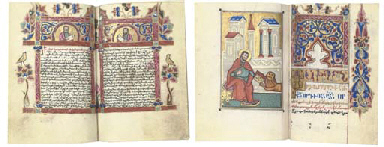Liber evangeliorum ac epistolarum pro festis solemnibus.... St. Ambronay (France): 1740. Gospel and Epistle Lectionary (second part), in Latin, 337 x 225 mm. Collation: ii (paper) + ii (vellum) + 66 (vellum) + ii (vellum) + ii (paper) leaves. Collation: [1-33 in 2s]. Copied and bound in successive quires that each consist of a single bifolium. Leaves 1/1 and 1 / 2 unnumbered; leaves 2/1-66/1 paginated 1-126 with stenciled Arabic numerals in upper margin at left or right. Text entirely stenciled in imitation of roman type. Pages 1-17 with eight lines of text, each under a line of music that consists square neumes on four-line red staves; pp. 18-122 with 17 long lines; pp.124-126 with 21 long lines. Ruled in lead with single bounding lines; written area: 205 x 155 mm. Running titles and lesser section titles in red roman capitals; major section titles in multi-colored decorative initials; 4- or 3-line square initial spaces for gospels or epistles, initials with floral or historiated backgrounds and space reserved for large roman capitals to be inserted in gold ink; floral headpieces precede each feast, some including historiated vignettes; floral or decorative cartouches follow the epistle in many sections. (Small natural flaw to blank margin of the leaf paginated 53-54, otherwise in excellent condition.) Re-cased in original binding of red velvet over pasteboards, marbled endleaves (metal furniture removed, some fraying to corners and board edges), in a custom morocco-covered case. Provenance: Benedictine Abbey of Ambronay (located northeast of Lyon), 1740 (title page); nineteenth-century cipher centered on a large letter V, flanked probably by E and B and surmounted by a coronet (gilt-stamped on front cover, bookplate). The decoration of the manuscript was designed with elegance and carried out with skill. However, it was never completed. Although 62 pages have one or more forms of decoration, it has been fully realized only on pages 51-86. Elsewhere most decorated pages have only the flat undercoat laid on; modelling in additional colors occurs only on some pages; gold initials are found only on pp. 58-81; and pp. 110-120 have only headpieces sketched in lead. Thus the manuscript demonstrates in a remarkable way the techniques by which miniatures were designed and executed as late as the mid-eighteenth century. Stenciled books are a curiosity in the history of book production. They are manuscripts in that they were created by hand, but with the mechanical aid of stencils. They can be recognized by the gaps between parts of letters, since stencils cannot produce completely enclosed spaces. Such books were especially popular in the seventeenth and eighteenth centuries, when stencils were often used to produce large-format books of music for communal singing and texts such as the present lectionary intended for public reading. The manuscript was made for the Benedictine Abbey of Ambronay, as stated on the title page: "Liber Evangeliorum ac Epistolarum, pro Festis Solemnioribus. Ad usum Ecclesiae et Abbatiae Regiae Beatae Mariae Virgiis de Ambroniaco. Ordinis S. Benedicti e Congragatione Sancti Mauri. Pars altera." It combines moveable feasts from the Proper of the Times with a selection of fixed feasts from the Proper of the Saints presented in a single quasi-chronological sequence beginning with the Easter Vigil and ending with All Saints. Several important Benedictine saints or feasts are included: the translation of St. Benedict (from Monte Cassino in Italy to Fleury in France); Saints Placidus and Maurus (the first disciples of St. Benedict, they share a feast day); St. Hugo, Abbot of Cluny (the most important Benedictine monastery in France); and a feast dedicated to the saints of the Benedictine order. A short addendum at the end of the main text provides for commemorations of the dead. The Congregation of St. Maur was formed in France in the early seventeenth century and existed until the French Revolution. It was known f
Liber evangeliorum ac epistolarum pro festis solemnibus.... St. Ambronay (France): 1740. Gospel and Epistle Lectionary (second part), in Latin, 337 x 225 mm. Collation: ii (paper) + ii (vellum) + 66 (vellum) + ii (vellum) + ii (paper) leaves. Collation: [1-33 in 2s]. Copied and bound in successive quires that each consist of a single bifolium. Leaves 1/1 and 1 / 2 unnumbered; leaves 2/1-66/1 paginated 1-126 with stenciled Arabic numerals in upper margin at left or right. Text entirely stenciled in imitation of roman type. Pages 1-17 with eight lines of text, each under a line of music that consists square neumes on four-line red staves; pp. 18-122 with 17 long lines; pp.124-126 with 21 long lines. Ruled in lead with single bounding lines; written area: 205 x 155 mm. Running titles and lesser section titles in red roman capitals; major section titles in multi-colored decorative initials; 4- or 3-line square initial spaces for gospels or epistles, initials with floral or historiated backgrounds and space reserved for large roman capitals to be inserted in gold ink; floral headpieces precede each feast, some including historiated vignettes; floral or decorative cartouches follow the epistle in many sections. (Small natural flaw to blank margin of the leaf paginated 53-54, otherwise in excellent condition.) Re-cased in original binding of red velvet over pasteboards, marbled endleaves (metal furniture removed, some fraying to corners and board edges), in a custom morocco-covered case. Provenance: Benedictine Abbey of Ambronay (located northeast of Lyon), 1740 (title page); nineteenth-century cipher centered on a large letter V, flanked probably by E and B and surmounted by a coronet (gilt-stamped on front cover, bookplate). The decoration of the manuscript was designed with elegance and carried out with skill. However, it was never completed. Although 62 pages have one or more forms of decoration, it has been fully realized only on pages 51-86. Elsewhere most decorated pages have only the flat undercoat laid on; modelling in additional colors occurs only on some pages; gold initials are found only on pp. 58-81; and pp. 110-120 have only headpieces sketched in lead. Thus the manuscript demonstrates in a remarkable way the techniques by which miniatures were designed and executed as late as the mid-eighteenth century. Stenciled books are a curiosity in the history of book production. They are manuscripts in that they were created by hand, but with the mechanical aid of stencils. They can be recognized by the gaps between parts of letters, since stencils cannot produce completely enclosed spaces. Such books were especially popular in the seventeenth and eighteenth centuries, when stencils were often used to produce large-format books of music for communal singing and texts such as the present lectionary intended for public reading. The manuscript was made for the Benedictine Abbey of Ambronay, as stated on the title page: "Liber Evangeliorum ac Epistolarum, pro Festis Solemnioribus. Ad usum Ecclesiae et Abbatiae Regiae Beatae Mariae Virgiis de Ambroniaco. Ordinis S. Benedicti e Congragatione Sancti Mauri. Pars altera." It combines moveable feasts from the Proper of the Times with a selection of fixed feasts from the Proper of the Saints presented in a single quasi-chronological sequence beginning with the Easter Vigil and ending with All Saints. Several important Benedictine saints or feasts are included: the translation of St. Benedict (from Monte Cassino in Italy to Fleury in France); Saints Placidus and Maurus (the first disciples of St. Benedict, they share a feast day); St. Hugo, Abbot of Cluny (the most important Benedictine monastery in France); and a feast dedicated to the saints of the Benedictine order. A short addendum at the end of the main text provides for commemorations of the dead. The Congregation of St. Maur was formed in France in the early seventeenth century and existed until the French Revolution. It was known f











.jpg)

.jpg)
.jpg)
Testen Sie LotSearch und seine Premium-Features 7 Tage - ohne Kosten!
Lassen Sie sich automatisch über neue Objekte in kommenden Auktionen benachrichtigen.
Suchauftrag anlegen